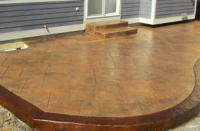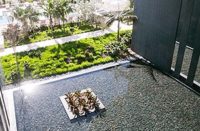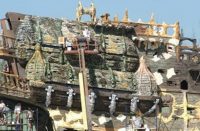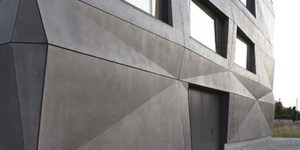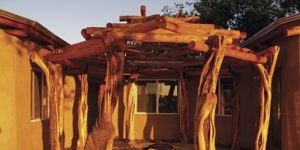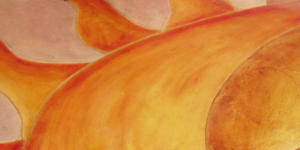
In FuTung Cheng’s view, the term “decorative concrete” fails to convey the full measure of the material’s prowess in enhancing design. Coloring, texturing, stamping or staining don’t begin to tell the whole story.
Cheng, widely acknowledged as a leading figure in the use of concrete in architecture and often hailed as a “guru” in the building trade, considers concrete “integral” to design and architecture. The use of concrete extends beyond interior space and the objects within, such as countertops and fireplaces. It’s about the space itself being surrounded and embodied by the sculptural envelope of a substance. It’s about the whole of architecture.
“I like to use it structurally and integrally — form and function integrated together,” says Cheng. “You can treat the surface while the structure is poured in place. You have infinite opportunities to mold it, texture it, sculpt it, color it and refine it, simultaneously with the structural pour.”
Cheng cites a recent residential project in which color, design and texture were incorporated into poured concrete wall structures. Each four-foot “lift” provides the physical access to the forms to allow placement of bands of color and aggregate. It simulates the process nature might take over millennia to stratify layers of sediment in bands to form a hillside cliff face.
Why and how designers use decorative concrete in their projects is as much philosophical as it is based in aesthetics. Cheng and other designers offer their views on design and the role played by concrete — and in particular decorative concrete — in a wide-ranging discussion.

The choice of concrete
Cheng, founder and head of Cheng Design in Berkeley, California, says designers first must determine what they seek to convey in a project, then weigh whether concrete is the right architectural finish. In Cheng’s specialty of residential projects, he first strives to interpret the client’s intent and desires for the home.
“The essential question is have they seen our work? Is the use of concrete one of the primary reasons for the attraction to our design work? If so, what attracts them to concrete?” he asks. “Usually it’s the gut feeling of mass and substance — both structural and decorative — that speaks directly to their emotions. It’s not a coating. It isn’t veneer. It’s integral and real.”
Michael Pape, landscape architect and head of Michael Pape & Associates in Ocala, Florida, agrees. “Overwhelmingly, design decisions to use concrete are based on aesthetics and durability,” he says, and the latter often translates into environmental benefits and sustainability.
Marley Porter, president and principal of Living Architecture and Construction Management based in Cottonwood, Texas, has a bulging portfolio of decorative concrete projects to his name. He extols the material’s myriad strengths and qualities. “Concrete is one of the most versatile, flexible, organic, structural, aesthetically potent materials on earth,” he says. “Concrete can lie flat or spring out and soar. Concrete can be the ‘big heavy’ in composition or concrete can float like a fairy on a feather. Architects abuse concrete too often because they don’t understand its inherent nature: frozen movement.”

Porter’s unique spin: “When concrete is thought about as only an architectural finish, it’s like me thinking about my wife’s pretty sundress instead of me thinking about the woman within. Concrete finishes are the dress. The power comes from what’s under the finish.”
He elaborates: “Concrete finishes should echo what they cover. They should extend the intent of what the concrete inside wants.” He provides an example of entering an asymmetrical room that is angled on one side, open on the other and looks over a pool just outside a big picture window opposite the door. In this example, on the floor is a fancy, decorative concrete compass that does nothing for the space except compete for the pool’s attention.
“Score the concrete to be what the room is and use the decorative nature to do what the room wants the occupant to do . . . and that is not to look down and proclaim, ‘Oh my, another unique and totally outrageous compass!’”

Outside the box
The emergence of concrete as flooring has added a new dimension to the material’s vast design adaptations — and to its value as a flooring alternative, says Amie Lindsay, architect and principal with Delineation Inc. in Fort Wayne, Indiana.
“There are clients who like the industrial feel to an urban space. Finishing the existing concrete floor is such a great way to give character to a space,” Lindsay says. “There are many options to stain that provide the look/color that fits the interior design.”
Susan Fredman, of Fredman Design Group in Chicago, says she will specify concrete as the solution when they are “looking for the natural imperfect perfection that concrete provides.”
Pape says, “For the exterior environments in which landscape architects work, there are no durable finishes that match concrete in terms of flexibility of installation, as well as in the broad range of design effects that are so important aesthetically.”
For Cheng, concrete’s advantages over alternative “traditional” materials begin with its nearly limitless creative potential.

“With decorative concrete products such as countertops, you can mold them and sculpt them, and provide practical design solutions such as drain boards, rather than plain Jane, bologna-and-white-bread kinds of kitchens,” he says. “As in all design, changing the subtle proportions of an object is tantamount to a magician changing your perceptions in the creation of an illusion — the surprise of seeing the ordinary presented extraordinarily with the sensations stimulated by the look and feel of concrete touches our primal comfort-response to a beautiful stone in nature.”
Rather than being mass produced, concrete countertops can be crafted, customized, personalized and tailored to an individual’s needs and a kitchen’s design requirements.
Cheng scales up the design themes and principles from kitchens to the whole residential structure. For example, take the staircase in a Los Altos Hills, California, residence Cheng calls “House 7,” a winner of a 2014 International Design Award. The walls were poured on site, and the stairs were made in the shop, put in place and post tensioned. This is the principle of architectural integration in action. In this case, it’s a practical, functional element.
Selling the price
Cost to the client is cited as a major challenge in decorative-concrete designs and installations. “It is a common material for construction, but many clients are not aware of it being a finished material,” says Lindsay.
“It’s not something you can quantify immediately,” Cheng says of estimating a project’s cost. “People assume concrete is inexpensive, but doing elaborate formwork, creating something with permanence and value is not low cost.”
Clients see the final, beautiful result but don’t necessarily know what goes into achieving it. For example, if a designer doesn’t want the usual tie holes to be seen in finished concrete, very strong buttresses can be used but they are more costly than form-ties. The same goes with using special materials to get different effects. “You want the concrete to telegraph what you are trying to convey, with artistic textures rather than the look of giant retaining walls made with plywood forms. Those kinds of things add up,” he says.

“Sometimes I have to draw it on paper, explain that this is what I’m trying to do,” Cheng says. There’s a certain amount of psychology involved to instill the confidence needed to convince clients of a project’s worth.
Ballpark costs for Cheng’s residential designs range from $400 per square foot to as much as $800 per square foot. “This is one of the rewards of reaching this point,” he says. For him, multimillion-dollar residences are commonplace, if not routine.
Imagination and inspiration
In the design drama, Porter says, decorative concrete methods and materials play a number of roles. “They support. They reflect. They augment. They dress. They genuflect and are subservient to the intent of the architecture unless the architecture is all about letting go and going crazy. Then the concrete products can lift, explode, go three-dimensional, spin, slice and dance. Make the design process integral by bringing the products in before the concrete is placed. Otherwise, it’s a tired and dirty dress on the floor.”
Pape seconds the motion, minus the abstractions and amplifications: “Nothing can match the flexibility and range of treatments available with decorative concrete,” he says.
Fredman calls decorative concrete’s aesthetic “unmistakable.”
Pape invites a look at Brownwood Town Center at The Villages in Florida as an “incomparable example of a project where no other material but decorative concrete could have achieved the various design effects that enhanced the unique character and user appeal of the project.”
At Brownwood, Pape and contractor Edwards Concrete conveyed the look and feel of a 19th-century cattle town in central Florida complete with the footprints of cows and wildlife in a sunbaked corral. Except that the sunbaked mud is colored concrete.

“No other paving surface could have replicated the effect of dried mud that gave such a striking thematic quality to the job,” Pape says. “And the thousands of people who visit the project each week are amazed and impressed by that.”
Going rogue
Going rogue, designers can forge their own interpretations well beyond anything shown in a product video or application guide, Cheng says.
“Again, it’s using concrete elements that you mold and cast. This can stimulate thinking on how these designs can be used and crafted in the given situation. The creative possibilities are many.
“It’s a complex, intensive dance with all the materials available, including concrete, to come up with something aesthetic and structural,” he says. “There are so few memorable buildings, because the impetus in our society and the demands of capitalism for profit is all about ‘faster is better.’”
But going rogue can be an expensive process. Consider a setting where the decorative concept is natural, organic — like moss. Cheng’s been there and done that, incorporating a medium that fosters the growth of moss into a concrete wall in a rustic residential setting.
“Typically you have to pick and choose where you want to do something of this type. It can’t be done everywhere in the project,” he says. “It’s definitely for high-end projects, where the concept becomes part of the DNA of the whole building.
“Think of music; you are trying to set a mood, a sensibility. Architecture is much like that — selecting materials that will convey a certain feeling, and you are changing and adjusting — orchestrating materials and looking for new ways to convey the impression you’re trying to make. Complementing concrete with a wood floor, for example, is an ensemble approach.
That’s the kind of influence concrete can have for Cheng — and for anyone willing to be receptive to it. There are opportunities for innovative ways to use it, not just repeating what’s been done before, he says.
The story of Genesis
The thinking that concrete should be considered in projects can originate from client or designer. This species called decorative concrete is still maturing and evolving, and the notion that no idea is a bad one almost makes sense.
“As landscape architects who have the privilege of handling such an array of creative projects, we take every opportunity to recommend decorative concrete finishes and educate our clients on what can be done with them,” says Pape. “The success of such projects creates more demand and more opportunity for both design professionals and installers.”
For Cheng, a conversation of decorative concrete finishes typically originates with the client, who’s usually aware of his work. Some clients come to the table with a love of concrete, while others prefer a moderate dose for the design they have in mind.
In Cheng’s early days, most people didn’t realize concrete could be used for decorative treatments that could produce effects such as the look of terrazzo. Innovative design concepts drove meteoric expansion for Cheng Design, primarily ignited in 2004 by a multipage feature in the Los Angeles Times which was picked up by other publications around the country.
“Design was the story, design with concrete,” Cheng says. He remembers the Times writer initially inquired about granite countertops. But the story morphed into more varied design mediums since granite countertops “had become commonplace” and carried inherent limitations for forming and molding.
“The real story was design, is design,” Cheng says—a story that plays right into the strengths of concrete.
Additional Resources
FuTung Cheng: www.concreteexchange.com
Michael Pape: www.mpala.net
Marley Porter: www.livingarchitecture.com
Amie Lindsay: www.delineationarch.com
Susan Fredman: www.susanfredman.com
